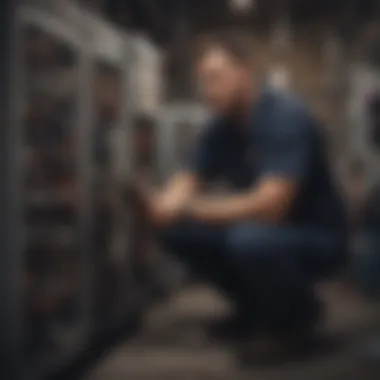The Essentials of Real Estate Maintenance


Intro
In the realm of real estate, maintenance is more than a mere checklist of tasks. It is a strategic discipline that influences property value and tenant satisfaction. A well-maintained property not only attracts renters but also enhances the owner's investment. Neglect, on the other hand, can lead to a downward spiral of deterioration and decline.
Maintenance includes preventive actions, timely repairs, and the use of technology for sustainable practices. Understanding these essential components is crucial to managing any property effectively. This guide delves into the multifaceted world of real estate maintenance, highlighting best practices and innovative approaches to ensure properties remain attractive and functional.
Featured Homes
Architectural Highlights
When considering the maintenance of a property, one must first acknowledge its architectural significance. Unique architectural designs call for specific maintenance approaches. For instance, a mid-century modern home may require special glazing treatments for its large windows, while a Victorian-style property could necessitate regular paintwork to preserve its intricate details.
Understanding these nuances allows property managers to tailor their maintenance strategies, ensuring that the visual integrity of the home is preserved.
Interior Design Themes
Interior spaces are equally important. The design theme can dictate maintenance needs. A minimalist aesthetic may mean fewer materials to manage, while more elaborate designs with multiple textures can increase maintenance complexity.
Here are some common interior themes and their maintenance considerations:
- Modern: Often requires regular cleaning and occasional refinishing of surfaces.
- Traditional: May need periodic inspections of antique furniture and materials.
- Eclectic: Diverse elements necessitate unique care for each piece.
Understanding these aspects ensures that properties are both beautiful and functional, maintaining their appeal for longer periods.
Location Spotlights
Cultural Significance
Cultural factors greatly influence property maintenance. Properties in urban areas might experience higher foot traffic, which can result in quicker wear and tear. Conversely, homes in quieter regions may not need as frequent upkeep. Knowing the cultural context can help property managers allocate resources more effectively.
Natural Wonders
Natural elements also play a role in maintenance. For example, properties near bodies of water must contend with humidity-related issues, while homes in arid regions may face challenges with dust accumulation. A solid maintenance plan will consider these environmental factors, ensuring that properties remain resilient against nature's elements.
Ending
To sum up, real estate maintenance is a complex but rewarding endeavor. By addressing architectural uniqueness, interior design themes, and local factors that affect upkeep, one can enhance property value and tenant satisfaction.
"Effective maintenance not only preserves aesthetic appeal but is critical for long-term investment success."
As we continue to explore this guide, we will further unravel the strategies essential for sustainable real estate management.
Understanding Real Estate Maintenance
Real estate maintenance is crucial in preserving the value and functionality of properties. Understanding its various aspects allows property owners, managers, and tenants to have a clear picture of their responsibilities and the implications of neglecting maintenance tasks. When maintenance is planned and prioritized, it leads to longer-lasting properties and better tenant experiences.
Definition and Importance
Real estate maintenance refers to the activities carried out to ensure that a property remains functional, safe, and appealing. It is defined by both preventative measures and required repairs. The importance of maintenance lies not only in preserving property value but also in ensuring tenant satisfaction. A well-maintained property will attract higher-quality tenants and retain them longer, directly influencing rental income. Proper maintenance practices can also reduce costly emergency repairs, making good financial sense in the long term.
Types of Real Estate Maintenance
Maintaining properties consists of different types of maintenance, each serving a purpose in preserving the integrity of the building.
Preventive Maintenance
Preventive maintenance involves scheduled inspections and upkeep activities designed to prevent potential breakdowns. Its key characteristic is the proactive approach to maintenance, meaning problems are addressed before they escalate. This strategy is popular among property managers due to its cost-effectiveness. A unique feature of preventive maintenance is the ability to create a maintenance calendar that outlines tasks by season or frequency. The advantages include reduced risk of major repairs and a smoother management process, while the downside might be the initial costs of setting up a preventive program.
Corrective Maintenance
Corrective maintenance occurs when something is broken or not functioning as expected. The primary focus is on repairs post-issue rather than prevention. This type of maintenance is necessary when unexpected failures happen and can disrupt tenant satisfaction and property operations. Highlighting immediacy, corrective maintenance is essential because it directly addresses issues impacting safety or comfort. However, it can be more expensive in the long run as it often results in larger bills for repairs, emphasizing the value of preventive strategies.


Routine Maintenance
Routine maintenance consists of standard tasks performed regularly to ensure that everything is operating smoothly. Tasks include things like cleaning gutters, changing air filters, and minor landscaping. One of its key characteristics is frequency; these tasks are often scheduled monthly or quarterly, depending on the building's needs. Routine maintenance is beneficial because it helps create a consistent standard of quality for the property. However, it may sometimes be perceived as a lower priority compared to immediate corrective actions, which can lead to its neglect.
Electrical and HVAC Maintenance
Electrical and HVAC maintenance focuses on the critical systems that keep a building functional. This type of maintenance can include regular inspections of electrical systems, testing alarms, and servicing heating and cooling systems. The main characteristic is the complexity and safety involved in handling these systems, which require professional involvement. Its uniqueness lies in the fact that issues can arise unexpectedly, affecting tenant comfort and safety. Neglecting such maintenance can result in costly repairs or even potential hazards, underscoring its importance in overall property management.
Preventive Maintenance Strategies
Preventive maintenance strategies play a crucial role in real estate management. They are proactive measures taken to prevent potential problems before they occur. By implementing these strategies, property owners can significantly reduce long-term costs, improve tenant satisfaction, and extend the lifespan of the properties. Understanding how to effectively apply these strategies can provide a clear advantage in maintaining high-value investments.
Scheduled Inspections
Scheduled inspections are one of the cornerstones of preventive maintenance. Regular assessments enable property managers to identify issues at early stages, preventing minor repairs from escalating into major problems. For example, examining roofs periodically can reveal small leaks before they lead to water damage.
Some key points about scheduled inspections include:
- Regularity: Establishing a routine schedule ensures that all areas of the property are monitored consistently.
- Documentation: Keeping detailed records of inspections helps track the condition of various structures and systems within the property.
- Professional Assessments: Engaging professionals for specific systems like electrical or plumbing can offer insights that a non-expert might miss.
Overall, scheduled inspections serve as a deterrent against costly repairs down the line, reinforcing the property's integrity and safety.
Seasonal Maintenance Checklists
Seasonal maintenance checklists are another effective component of preventive maintenance. These lists outline specific tasks that should be completed during different times of the year. For instance, winter preparations may focus on sealing windows and insulating pipes, while summer tasks could include checking air conditioning units.
Creating seasonal checklists has multiple advantages:
- Comprehensive Coverage: They ensure that all necessary maintenance tasks are addressed, reducing the likelihood of overlooking critical areas.
- Resource Planning: By knowing in advance what needs attention, property managers can allocate resources better and avoid last-minute rushes.
- Tenant Communication: Providing tenants with seasonal checklists fosters transparency. Tenants are informed about what to expect and can assist in certain areas if needed.
Checklists streamline the maintenance process and help maintain comfort and safety within the property throughout the year.
Cost-Benefit Analysis
A systematic cost-benefit analysis of preventive maintenance is essential for demonstrating its value. This analysis weighs the costs incurred from maintenance activities against the potential benefits gained from them. For instance, while a scheduled inspection incurs a cost, the identification and correction of even a minor issue can save thousands in emergency repairs later.
Key considerations in conducting a cost-benefit analysis include:
- Quantifying Costs: Include labor, materials, and time spent on preventive tasks.
- Evaluating Risks: Assess the potential costs of failing to perform maintenance by calculating risks related to property damage or tenant dissatisfaction.
- Long-Term Benefits: Highlight how good maintenance practices can enhance property value and improve tenant retention.
An effective cost-benefit analysis can substantiate the need for preventive maintenance and help secure support from stakeholders.
"Investing in preventive maintenance today can yield substantial returns tomorrow."
Through the thoughtful application of preventive maintenance strategies, property owners can create more sustainable, enjoyable, and valuable living environments.
Emergency Repairs: Best Practices
Emergency repairs are critical for maintaining the integrity of a property, both structurally and functionally. They ensure tenant safety, prevent further damage, and protect the property's overall value. Ignoring or delaying these repairs can result in greater costs down the line and lead to tenant dissatisfaction. Thus, understanding the best practices for emergency repairs is vital for property managers and landlords.
Identifying Priority Repairs
The first step in dealing with emergencies is to identify what repairs take precedence. Not all repair issues are created equal, and recognizing which ones pose more significant risks helps prioritize actions. Generally, repairs that affect health and safety must be escalated. For instance, a leaking pipe that threatens water damage should take priority over a minor electrical issue.
Other factors include the potential for damage escalation. For example:
- Structural damage: Roof leaks can lead to more severe damage, so they should be addressed quickly.
- Utilities: Issues with heating or air conditioning systems can affect tenant comfort and health.
Assessing the extent of the damage and its possible impact is essential in making informed decisions about which repairs deserve immediate attention.
Communication Protocols


Effective communication is essential when handling emergency repairs. Property managers should establish clear protocols for tenants to report issues and for maintenance teams to respond. A well-structured communication system reduces response time, leading to faster resolution of problems.
A few effective communication protocols include:
- 24/7 hotlines: Having a dedicated number allows tenants to report issues at any time.
- Written guidelines: Provide tenants with detailed steps for reporting emergencies.
- Regular updates: Keep tenants informed about the repair process and estimated resolution times. This transparency helps to maintain good relationships with tenants.
Documenting Repairs
Documenting repairs is another crucial best practice in emergency situations. A thorough record of all repair activities not only enhances accountability but also protects property owners from potential disputes.
Some recommended documentation practices are:
- Detailed logs: Keep a comprehensive log of what the issue was, actions taken, dates, and any parts used.
- Before-and-after photos: Visual evidence can provide clear context for any repairs made.
- Receipts and invoices: Maintain all financial records related to emergency repairs for future reference.
Proper documentation can also facilitate insurance claims if needed, ensuring that you are protected against potential losses.
"The efficiency with which property managers handle emergencies can directly influence tenant trust and occupancy rates."
Tenant Relations and Maintenance
Tenant relations play a pivotal role in the sphere of real estate maintenance. Good relationships between property managers and tenants can significantly influence tenant retention, satisfaction, and ultimately, the profitability of real estate investments. Managing tenant relationships effectively includes maintaining clear lines of communication, ensuring responsiveness to concerns, and engaging tenants in maintenance discussions. For property managers, establishing a culture of mutual respect and understanding helps create a positive environment, which can be beneficial in high-demand rental markets.
Communication with Tenants
Effective communication forms the backbone of successful tenant relations. Property managers should actively listen to tenant concerns and prioritize responding promptly. Regular updates regarding maintenance schedules or any changes affecting tenants help in nurturing trust. Text messages, emails, or even dedicated property management apps are tools that enhance communication. Clear, consistent messaging can prevent misunderstandings and create a cooperative atmosphere where tenants feel valued.
Feedback Mechanisms
Implementing structured feedback mechanisms allows tenants to express their thoughts about maintenance efforts and overall property conditions. Surveys and suggestion boxes can capture tenant experiences and perceptions. Analyzing feedback is essential, as it provides insights into areas for improvement, whether it's about maintenance responsiveness or property amenities. By embracing feedback, property managers not only address tenant needs but also build an engaged community invested in the property’s upkeep.
Enhancing Tenant Satisfaction
Enhancing tenant satisfaction goes beyond addressing immediate concerns. It involves creating a holistic living experience that prioritizes tenant needs. Offering amenities, organizing community events, and maintaining an aesthetically pleasing environment contribute to a positive tenant experience. Additionally, ensuring prompt and thorough maintenance reinforces the message that tenants' well-being is a priority. Happy tenants are likely to renew their leases, which reduces turnover costs and creates stability in rental incomes.
"A satisfied tenant often leads to a satisfied landlord."
Fostering excellent tenant relations is a strategic move that benefits all parties involved. By focusing on communication, feedback, and overall satisfaction, property managers can enhance both the living experience for tenants and the operational success of real estate investments.
Technology in Real Estate Maintenance
In today's evolving real estate market, technology plays a pivotal role in enhancing maintenance services. The integration of various technological solutions streamlines processes, improves efficiency, and encourages sustainability in property management. By utilizing advanced systems, property managers can reduce costs and play a vital role in maintaining property value while ensuring tenant satisfaction.
Maintenance Management Software
Maintenance management software serves as a backbone for real estate maintenance operations. This software allows property managers to organize tasks systematically. Key features of such software include:
- Task Management: Users can assign, track, and follow up on maintenance tasks easily.
- Inventory Management: Helps keep track of supplies and materials necessary for maintenance work.
- Scheduling: Facilitates the scheduling of routine checks and preventive maintenance tasks.
- Reporting and Analytics: Provides insights into maintenance trends and cost analysis of repairs.
Implementation of maintenance management software saves time, enhances accountability, and ensures that no maintenance task is overlooked. Moreover, it builds a structured approach to property upkeep, crucial for long-term success.
Mobile Applications for Property Management
Mobile applications have revolutionized property management. They provide a convenient platform for communication between property managers and tenants. With these applications, tenants can report issues directly, reducing delays in addressing problems. Key benefits of mobile applications include:
- Real-Time Communication: Tenants can submit maintenance requests instantly from their smartphones.
- Accessibility: Property management tools can be accessed any time, anywhere, increasing flexibility.
- Notification Alerts: Sends reminders for upcoming maintenance or inspections to both tenants and managers.
Investing in mobile applications supports proactive maintenance strategies. Tenants feel more involved, and property managers can maintain stronger relationships, boosting overall satisfaction.
Emerging Technologies: Smart Maintenance
Smart technologies introduce a new era in real estate maintenance. Internet of Things (IoT) devices, for example, play a significant role in monitoring systems and appliances in real-time. The beneficial aspects of smart maintenance include:


- Efficiency Monitoring: Smart sensors can track energy usage and alert managers of abnormal patterns, indicating malfunction or inefficiency.
- Automated Insights: Data collected from smart devices can predict maintenance needs before issues arise, allowing for timely interventions.
- Environmental Benefits: Smart maintenance often aligns with sustainability efforts by reducing waste and energy consumption.
Integrating smart technologies is not just an option; it is becoming a necessity. As properties grow more sophisticated, the need for effective smart maintenance solutions is paramount to preserve property integrity.
"Embracing technology in real estate maintenance is not just a trend; it is essential for success in a competitive marketplace."
By recognizing the importance of technology and investing in these advancements, real estate professionals can ensure that their properties are not only well-maintained but also positioned for long-term value appreciation.
Legal and Regulatory Considerations
In the realm of real estate maintenance, understanding legal and regulatory considerations is paramount. These elements play a crucial role in safeguarding property owners, tenants, and ensuring that all maintenance practices comply with existing laws. Adherence to these regulations not only protects against potential legal issues but also enhances the overall integrity and appeal of a property.
Understanding Property Laws
Property laws govern the rights and responsibilities of property owners and tenants. These laws vary by jurisdiction and can cover a wide range of areas, including leasing agreements, landlord-tenant relationships, and property use.
- Leasing Agreements: Contracts should outline maintenance responsibilities clearly. This clarity helps in preventing disputes between landlords and tenants. Detailed contracts ensure that both parties understand their legal obligations regarding maintenance work.
- Landlord-Tenant Relationship: Laws often outline the required conditions for living standards. Landlords must provide safe and habitable living conditions. This means addressing leaks, heating malfunctions, and pest control issues promptly. Non-compliance can lead to legal repercussions.
- Property Use Regulations: Zoning laws dictate how properties can be utilized. For example, a residential building cannot be converted into a commercial space without the necessary permits. Compliance with these laws is vital for maintaining property value and avoiding fines.
Potential violations can result in fines, litigation, or damage claims. Hence, property owners must stay informed about local laws and ensure their practices align accordingly.
Safety Compliance Requirements
Safety compliance requirements are crucial in real estate maintenance. These standards are established to protect tenants and property from hazards. Failure to meet these requirements can have serious consequences.
- Fire Safety Regulations: Properties must comply with fire codes, which may include having smoke detectors, fire extinguishers, and clear evacuation plans. Regular safety inspections ensure compliance and tenant safety.
- Health Regulations: Properties should also adhere to health codes. This includes ensuring clean water supply and pest control, as well as addressing mold and other health hazards promptly. Each state typically has specific health regulations that must be followed.
- Building Codes: Compliance with local building codes guarantees structural safety. These codes dictate maintenance practices such as electrical work, plumbing, and renovations. Non-compliance can result in fines and extended repairs, which can be costly.
Effective maintenance also means integrating safety compliance into routine practices. Regular audits and checks build a safe environment for tenants and protect property investments.
"Being proactive about legal and safety compliance can save property owners from significant damage and liability issues."
The intersection of property laws and safety regulations forms a complex but necessary framework. Understanding and integrating these elements into the maintenance strategy is not just a legal obligation; it is a fundamental step toward preserving the value and appeal of real estate.
Financial Aspects of Property Maintenance
Financial considerations form a crucial component of real estate maintenance. Managing the costs associated with upkeep not only ensures properties remain functional and aesthetically pleasing, but also significantly affects the bottom line for property owners and investors. By understanding the financial aspects linked to maintenance, stakeholders can make informed decisions that improve their properties, enhance tenant satisfaction, and ultimately support the long-term sustainability of their investments.
Budgeting for Maintenance
Effective budgeting is essential for maintaining a property successfully. A structured financial plan allows property owners to allocate resources efficiently, making sure both preventive and corrective measures are financially covered. Here are some critical points to consider regarding budgeting:
- Assess Historical Costs: Analyze past expenses for maintenance activities. This helps in estimating future costs reliably and allows for adjustments based on previous data.
- Plan for Unexpected Expenses: Set aside a portion of the budget for emergency repairs. Sudden issues can arise and having funds ready can prevent delays in maintenance.
- Regular Reviews: Continuously monitor the budget against actual expenses. This provides insights into areas where spending may be excessive and helps in refining future budgets.
- Include All Maintenance Types: Consider costs related to preventive, routine, and emergency maintenance when budgeting. Each type has a different financial implication, and overlooking any can lead to underfunding important aspects.
Impact on Property Value
The relationship between maintenance and property value is significant. Consistent and effective maintenance not only preserves but can also enhance the value of a property. Below are some aspects to consider:
- Market Perception: Well-maintained properties attract more prospective tenants and buyers. They foster a positive impression, making them desirable in competitive markets.
- Structural Integrity: Regular maintenance addresses potential issues before they escalate. This approach preserves the property’s value by ensuring its structural elements function correctly and remain safe for occupancy.
- Long-term Savings: Investing in maintenance often leads to lowered long-term costs. For example, a building with good HVAC maintenance typically experiences fewer breakdowns, reducing repair costs that can otherwise affect a property’s financial viability.
- Compliance with Regulations: Adhering to local property maintenance laws can prevent fines and avoid costly legal issues. Staying compliant keeps a property's value intact as well.
"Investing in maintenance not only keeps properties in prime condition but can also enhance their overall marketability."
In summary, understanding the financial aspects of property maintenance is vital for any real estate enthusiast. By creating a solid budget plan and recognizing the impact of maintenance on property values, owners can effectively manage their investments, ensuring that they are not only preserved but also optimized for future gains. Real estate management requires careful consideration of these elements to ensure a sound financial strategy.
Environmental Sustainability in Maintenance
Environmental sustainability in maintenance is essential, as it ensures that property management addresses the delicate balance between maintaining real estate value and protecting ecological integrity. Real estate assets inevitably interact with their environments, and a focus on sustainability can significantly bolster property appeal while also participating in larger efforts towards ecological conservation. This guide will underscore various aspects of this timely topic, including sustainable practices and energy efficiency upgrades, highlighting their benefits and necessary considerations.
Sustainable Practices
Sustainable practices in real estate maintenance refer to methods and strategies aimed at minimizing environmental impacts during upkeep and renovations. Implementing these practices can lead to multiple benefits:
- Resource Conservation: It is crucial to utilize resources such as water and energy efficiently. Keeping this in mind leads to lower operational costs and reduced consumption over the long term.
- Waste Reduction: Minimizing waste in maintenance operations plays a pivotal role in sustainability. For instance, recycling materials when renovating can keep significant amounts of debris out of landfills.
- Eco-Friendly Products: The use of green cleaning agents and sustainable materials in repairs not only enhances indoor air quality but also aligns with environmentally responsible choices.
Adopting sustainable practices requires a commitment to ongoing education about eco-friendly methods and products. Property managers can source information from reputable resources and industry guidelines to stay informed about the latest developments in environmental sustainability.
Energy Efficiency Upgrades
Energy efficiency upgrades are another crucial aspect of sustainable maintenance. These upgrades provide an opportunity to significantly lower energy consumption levels while enhancing the comfort and livability of spaces. Key elements to consider include:
- Insulation Improvements: Upgrading insulation in ceilings, walls, and floors can greatly reduce heating and cooling costs. A well-insulated property conserves energy by keeping desired temperatures stable.
- Energy-Efficient Appliances: Replacing outdated appliances with ENERGY STAR-rated models can decrease both energy consumption and utility bills. Tenants appreciate the long-term savings these upgrades provide.
- Smart Technology: Integrating smart thermostats and lighting systems allows for more precise control of energy use. These technologies can adjust automatically based on occupancy and environmental conditions.







